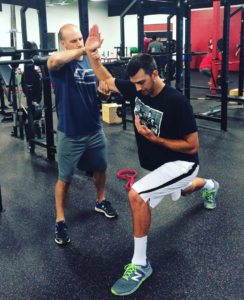
Random Thoughts on Sports Performance Training: Installment 3
My random thoughts on sports performance training always seem to be a hit with readers, so I figured I’d turn it into a series I update every month or two. Here are five thoughts that have been rattling around my brain, in no particular order:
1. Anyone who reads this blog regularly knows that we use a ton of positional breathing drills. If you’d like some example, just check out Greg Robins’ post from a few days ago here.
With that said, one of the biggest mistakes we made when we starting integrating these drills was not encouraging a “reset” at the end of the full exhalation. Basically, when you cue an athlete to fully exhale, you want a count of 3-4 “one-thousand” before they inhale again. Effectively, this gives an athlete a chance to a) get familiar/comfortable with this less extended position and b) regulate breathing rate (to turn off sympathetic activity). I’ve also found that it slows athletes down a bit so that they’re forced to focus on doing things perfectly, too.
2. One thing that drives me absolutely bonkers is when I see people opening their hands up while doing Turkish get-ups. First, the obvious: do you really want to hold a weight right over your face without gripping it? Second, there are so many remarkable benefits from just gripping something, most notably increasing reflexive recruitment of the rotator cuff. If anyone has a legitimate rationale for opening the hand with the kettlebell overhead, I’d love to hear it – but nobody has been able to justify it to me as of yet.
3. I just finished up Charlie Weingroff’s new DVD set, Lateralizations and Regressions, and particularly enjoyed the section he devoted to the “packed neck.” Back around 2008, it was a change I made with not only my own training, but also how we coached our athletes – and it’s yielded profoundly positive results.
As Charlie pointed out, neck position impacts everything else in the body, particularly with respect to optimizing thoracic mobility and scapular control. I think that sometimes, people discount the importance of neck positioning when teaching beginners, assuming they can just teach it later on in a training plan. In my eyes, when you allow people to deadlift (or perform any lift) while looking up (instead of maintaining a neutral cervical spine with eyes straight ahead), you’re really just giving them a faulty compensation pattern to reposition their center of mass. It’s a cue that should be provided from day 1.
For more information on Charlie’s new resource, click here.
4. If you train athletes who commonly experience shoulder and elbow concerns – including those who have had surgery – and you don’t have a safety squat bar handy, you’re missing out on a hugely important piece of equipment. When it comes to axial loading (bar on the upper back or anterior shoulder girdle), it’s the bar we use more than any other – and it’s saved my squatting career, as I have a shoulder issue that doesn’t like back squatting.
They aren’t cheap, but to me, if you deal with these types of athletes/clients often, it’s an awesome investment, not an expense.
5. With the MLB Draft a few weeks away – and several Cressey Sports Performance guys expected to be selected early in the draft – one of the things I hear scouts talking about all the time is “projectability” – or where an athlete will be in the years ahead. This is especially important in a sport like baseball, where a player doesn’t just quickly ascend to the highest level, as you would see in the NBA or NFL. Instead, players usually log several years of minor league baseball, and the overwhelming majority of them never even actually make it to the big leagues.
To that end, in terms of projectability, scouts are always looking for players who might make big jumps in pro ball – whether it’s due to physical improvements, baseball-specific coaching, positional changes, or any of a number of other “windows of adaptation.” When you think about it in this context, the ideal would be to find a kid who hasn’t been involved in organized strength and conditioning programs, is weak and undeveloped, and hasn’t received good baseball coaching. There’s no place to go but up, right?
Well, the corollary to that is that these woefully underdeveloped kids are usually the ones who have the most wear and tear on their bodies. If they are throwing hard or demonstrating great bat speed, they’ve often spent years hanging out on passive restraints (e.g., ligaments) because the active restraints (e.g., muscles) haven’t been sufficient to pick up the slack. In other words, they’re injuries just waiting to happen. And, we know that having even just one surgery while in the minor leagues dramatically reduces a player’s chance of making it to “The Show;” in face, one MLB strength coach told me that it reduced the likelihood of a player making it to the big leagues by 50%.
So, you could really say that projectability is a balancing act for teams. You want athletes who aren’t completely tapped out physically, but at the same time, aren’t so fragile-looking that you think they’ll fall apart on you before you can even develop them. I think it’s why a lot of scouts love to see multi-sport high school prospects; it automatically shows that they’re “middle-of-the-road” athletes. They’ve got solid general athletic development and less wear and tear (because of no year-round baseball). Plus, they can pick up more advanced skills easier because they’ve expanded their motor learning pool with a wide variety of activities over the years. Coaching them once they’re in pro ball is generally easier than it would be with a kid who’s spent 12 months each year learning bad habits without ever wiping the slate clean for a few months. Plus, because they’ve played multiple sports, you know that they’ve learned to roll with different social circles – and playing professional baseball will certainly test their abilities to interact with a wide variety of people.
Just food for thought from a guy who’s not a scout, but can’t help but make observations from a pretty informed perspective.




